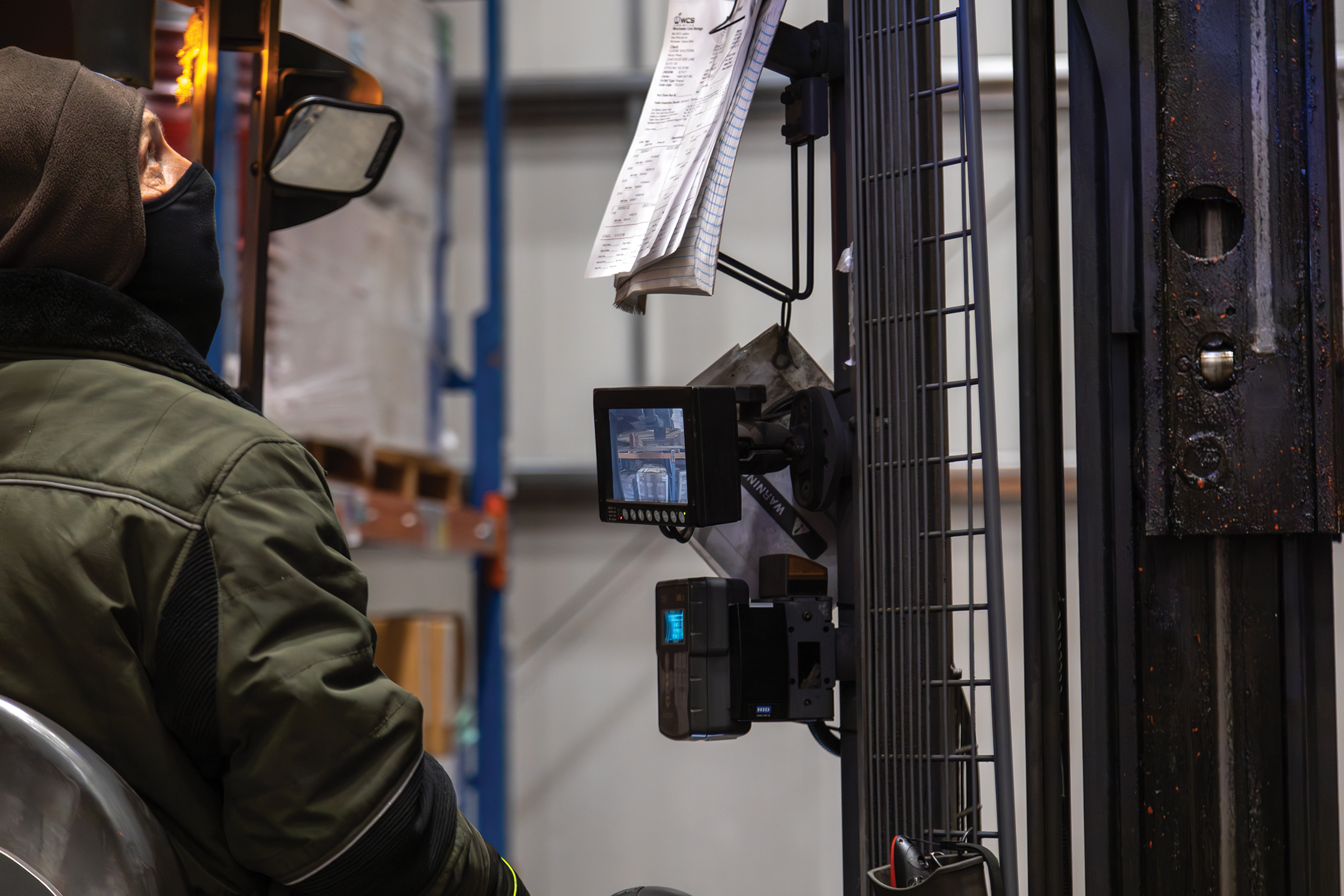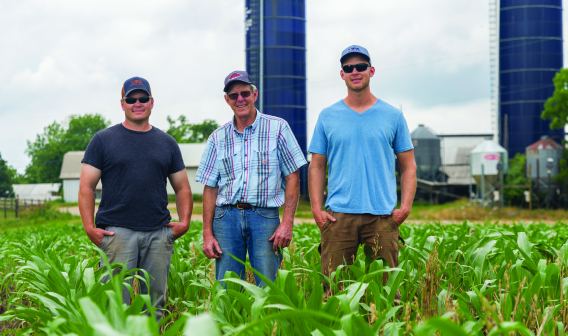In Complete (Climate) Control
Food and beverage, pharmaceutical companies rely on cold chain infrastructure to succeed in Virginia

WCS Logistics, Frederick County
As Virginia businesses build out and improve their cold chain infrastructure, they must be creative to grab a stake in the nation’s $42 billion business.
While the cold chain is based on keeping perishable food, beverages, and pharmaceutical products cold enough that they don’t spoil from factory to transport to warehouse, success for smaller companies can rely as much on sound decisions and sustainable instincts as anything else.
No one knows this better than Devon Anders. He’s president of InterChange Group, a midsized Rockingham County-based warehousing specialist that entered the cold storage business in 2019 after a valued customer asked him to.
“We went from being an 8-to-5 business to 24/7,” said Anders, who has since become intimately aware of the risks and rewards of cold storage. For all the high costs of entering the business, the financial rewards can be considerable. That’s what’s nudged entrepreneurs of all sizes in Virginia and across the globe to enter the industry.
A Maturing Ecosystem
Virginia certainly has plenty going for it as a place to ship and store cold products. Today, the biggest driver for cold storage construction in Virginia is the local prevalence of many big players in food and beverage and pharmaceuticals in and around the Commonwealth. All these industries are increasingly dependent on temperature-controlled storage facilities, said Anders.
Cold storage facilities in Virginia tend to follow the industries they serve. For InterChange, that’s the food and beverage industry that has flourished along the Interstate 81 corridor in the Shenandoah Valley, which is home to four of the top five agricultural localities in the Commonwealth.
Other cold storage hotspots in Virginia have developed next to key pieces of internationally focused infrastructure — Air Cartage Express has cold storage facilities for pharmaceutical clients adjacent to Washington Dulles International Airport and in Suffolk, convenient to The Port of Virginia, while InterChange and other companies have opened facilities in Hampton Roads, convenient to the port’s facilities there.
When Anders was looking at entering an already-established industry, he knew he had to get creative. He knew he was going up against the big boys like Lineage, United States Cold Storage, and Americold, which already had footprints along the I-81 corridor. He had to differentiate himself from the competition. That’s when he got the idea of topping his warehouse roofs with solar panels when he built and later expanded the facility.
“We were the first in the state to do this,” he said. “I thought we’d missed the boat, but we were actually ahead of the curve.”
We were the first in the state to do this. I thought we’d missed the boat, but we were actually ahead of the curve.
There’s not enough space on the warehouse roofs to generate sufficient solar power to refrigerate the entire building. Still, InterChange is offsetting roughly one-third of its monthly electric bill — which, next to its workforce of 400 employees, is one of its larger expenses. Seven years later, the solar paneling has already paid for itself, and with a projected lifespan of 20 years, the rest is gravy.
Speculative Build Slowdown
In Virginia, and nationally, the post-pandemic cold storage construction boom has slowed a bit. What’s not completely clear, said Anders, is where it will go from here. Broadly speaking, speculative cold storage construction is increasingly being replaced by build-to-suit opportunities, according to recent research by Colliers International.
Even then, the projected slowdown may be short-term, said the Colliers study, which estimates the average age of cold storage buildings in the nation’s top markets at 31 years old. That will ultimately lead to a demand for more modern, efficient spaces and an increase in new cold storage construction. Concurrently, cold storage construction could also be boosted over time by global growth in the perishable product trade.
That’s why competitors like WCS Logistics, formerly Winchester Cold Storage, are looking to Virginia for growth. WCS was founded in 1917 as a company focused exclusively on apple storage, a strong business in its home markets of Frederick County and Winchester.
Just a few years later, it added 370,000 square feet of storage space on 14 floors and suddenly held the title of the largest apple storage facility in the world.
Within a decade, WCS evolved from storing apples on the floor to storing them in huge barrels. And in the 1950s, it started converting those to controlled atmosphere storage rooms. It wasn’t until the 1970s that it started to add freezers. Today, the company is completely out of the apple business and has transformed into a cold storage facility that houses products from frozen vegetables to poultry.
The shift made things more complicated for WCS — because industries where there is no room for compromise on room temperature require alarms for the alarms.
“I can’t even tell you how many different alarms we have across our facilities to alert us to any problems,” said Peter Yates, WCS’s chief operating officer and general manager. These automatic alarms are tied into everything from freezer temperatures to the operation of the freezer condensers to the proper mixture of carbon dioxide and ammonia in the freezers.
WCS’s location in the Northern Shenandoah Valley is an asset, convenient to Interstates 81 and 66, as well as the Virginia Inland Port (VIP), an intermodal facility in Warren County that plays a major role in the cold chain in the area. Food products come in from The Port of Virginia’s Hampton Roads facilities, then are transported to the VIP, where they can be quickly moved to value-added processors in the I-81 corridor, then quickly out to market.
Ensuring Food Safety
Perhaps the single biggest impetus for cold storage construction in Virginia and elsewhere dates back almost 15 years. The Food Safety Modernization Act (FSMA), signed into law in 2011, shifted focus across the industry from responding to foodborne illness to preventing it.
That was a serious shot in the arm to the cold storage industry. Suddenly, perishables that used to be stored on unrefrigerated docks now had to be stored in chilled facilities that ensured specific temperatures, including eggs, soft cheeses, various vegetables, fish, and shellfish. The law also established requirements for information sharing between carriers and facilities and requires companies to maintain records on food shipments for two years.
Another unlikely growth catalyst was the COVID-19 pandemic. Because of the nature of the business, InterChange was viewed by the federal government as an “essential” business during the pandemic and could continue operating when other companies could not. “We had to help keep the grocery shelves full,” said Anders.
While pharmaceutical products were not covered under the FSMA, the industry is highly regulated. The U.S. Food and Drug Administration requires pharmaceutical companies to demonstrate that their products are stored and transported under appropriate conditions. Proper temperature control across the pharmaceutical supply chain is particularly crucial for vaccine efficacy.
Anders estimated that it costs roughly three times more to build and operate a cold storage facility than dry storage. That’s one reason why so many hedge funds have jumped onto the bandwagon. The demand for cold storage has been driven by things like growth in online grocery shopping, food company consolidation, and the growing need for temperature-controlled storage for pharmaceuticals. Hedge funds are particularly lured by the cold storage industry’s stability and its unique resilience during economic cycles and downturns.
Primed For Growth
Nationally, Anders said, the cold storage industry is projected to enjoy an annual growth rate of 15% to 18%, and if that holds true, it could be a positive sign for growth in Virginia.
Because it costs so much to enter the cold storage industry, competition is limited as well. Even then, the very existence of smaller players like InterChange is what makes the cold chain industry in Virginia so fascinating.
InterChange was founded in 1993, when its founders turned an old factory in Augusta County into a warehouse. Anders came aboard in 1997, when the company built another warehouse in Rockingham County. By 2000, they had 10 employees and five dry storage warehouses, and the company has since opened a sixth warehouse in Warren County.
Then came the move into cold storage. The company had started out in the field when it converted one warehouse to cold storage back in 2003, after a customer specifically requested it.
Since then, it has learned that it’s usually more economical to build new cold storage facilities from the ground up. Between 2019 and 2022, InterChange built a state-of-the-art cold storage facility with more than 430,000 square feet of storage space.
At this point, InterChange has nearly 1 million square feet of temperature-controlled space across Virginia. The potential payoff is the big driver.
“The barrier to entry is higher due to the capital costs,” Anders said. “In general, it’s risk-reward. Your risk is higher, so your reward will be higher.”
“At a lot of cold storage operations, the pickers and packers and such can only be in those environments for 20 or 30 minutes at a time before they need to step out to warm up,” said Joe Dunlap, chief supply chain executive for real estate company Legacy Investing. “Automating more of that space will also benefit those employees working in somewhat harsh environments.”
Expanding Opportunities
That potential reward has enticed Anders to continue expanding into cold storage. InterChange has invested more than $100 million into cold storage expansions in the last seven years.
And there’s more to come. The company is planning yet another $35 million cold storage expansion in Rockingham County that will help serve the needs of the region’s major food and beverage businesses. The next phase will add more than 150,000 square feet to its largest facility, bringing the final capacity to more than 600,000 square feet.
WCS, meanwhile, views itself as occupying the proper space within the Virginia cold storage ecosystem, having opened two new cold storage facilities in the past six years and bringing nearly 150,000 square feet of storage online. Yates called the company “big enough, but small enough” — big enough to provide the same services as bigger companies, but small enough to provide the customer a direct connection to the company’s managers.
While cold storage specialists like InterChange and WCS might appear to be blips on the overall cold storage screen, they represent the essence of why many companies turn to Virginia as a key link in the global cold chain.




